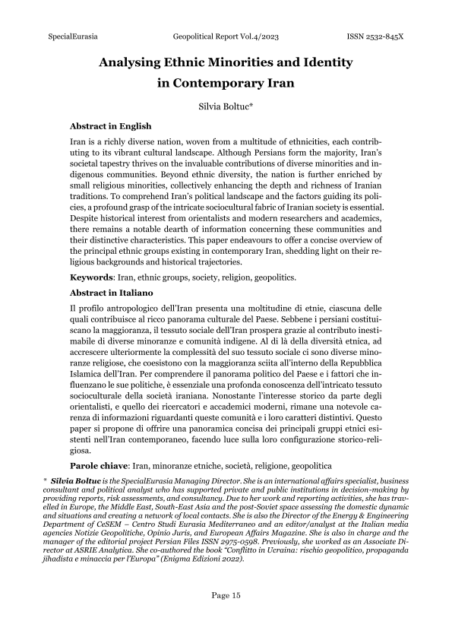Analysing Ethnic Minorities and Identity in Contemporary Iran

Title: Analysing Ethnic Minorities and Identity in Contemporary Iran
Publication: Geopolitical Report ISSN 2532-845X
Authors: Silvia Boltuc
Citation: Silvia Boltuc, “Analysing Ethnic Minorities and Identity in Contemporary Iran”, Geopolitical Report ISSN 2532-845X, Vol.4, 2023, pp. 15-32.
Abstract in English
Iran is a richly diverse nation, woven from a multitude of ethnicities, each contributing to its vibrant cultural landscape. Although Persians form the majority, Iran’s societal tapestry thrives on the invaluable contributions of diverse minorities and indigenous communities. Beyond ethnic diversity, the nation is further enriched by small religious minorities, collectively enhancing the depth and richness of Iranian traditions. To comprehend Iran’s political landscape and the factors guiding its policies, a profound grasp of the intricate sociocultural fabric of Iranian society is essential. Despite historical interest from orientalists and modern researchers and academics, there remains a notable dearth of information concerning these communities and their distinctive characteristics. This paper endeavours to offer a concise overview of the principal ethnic groups existing in contemporary Iran, shedding light on their religious backgrounds and historical trajectories.
Keywords: Iran, ethnic groups, society, religion, geopolitics.
Abstract in Italiano
Il profilo antropologico dell’Iran presenta una moltitudine di etnie, ciascuna delle quali contribuisce al ricco panorama culturale del Paese. Sebbene i persiani costituiscano la maggioranza, il tessuto sociale dell’Iran prospera grazie al contributo inestimabile di diverse minoranze e comunità indigene. Al di là della diversità etnica, ad accrescere ulteriormente la complessità del suo tessuto sociale ci sono diverse minoranze religiose, che coesistono con la maggioranza sciita all’interno della Repubblica Islamica dell’Iran. Per comprendere il panorama politico del Paese e i fattori che influenzano le sue politiche, è essenziale una profonda conoscenza dell’intricato tessuto socioculturale della società iraniana. Nonostante l’interesse storico da parte degli orientalisti, e quello dei ricercatori e accademici moderni, rimane una notevole carenza di informazioni riguardanti queste comunità e i loro caratteri distintivi. Questo paper si propone di offrire una panoramica concisa dei principali gruppi etnici esistenti nell’Iran contemporaneo, facendo luce sulla loro configurazione storico-religiosa.
Parole chiave: Iran, minoranze etniche, società, religione, geopolitica
Author Bio
Silvia Boltuc is the SpecialEurasia Managing Director. She is an international affairs specialist, business consultant and political analyst who has supported private and public institutions in decision-making by providing reports, risk assessments, and consultancy. Due to her work and reporting activities, she has travelled in Europe, the Middle East, South-East Asia and the post-Soviet space assessing the domestic dynamic and situations and creating a network of local contacts. She is also the Director of the Energy & Engineering Department of CeSEM – Centro Studi Eurasia Mediterraneo and an editor/analyst at the Italian media agencies Notizie Geopolitiche, Opinio Juris, and European Affairs Magazine. She is also in charge and the manager of the editorial project Persian Files ISSN 2975-0598. Previously, she worked as an Associate Director at ASRIE Analytica. She co-authored the book “Conflitto in Ucraina: rischio geopolitico, propaganda jihadista e minaccia per l’Europa” (Enigma Edizioni 2022).
